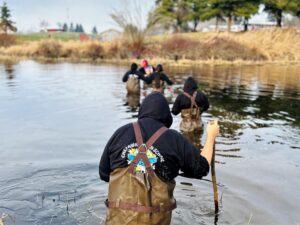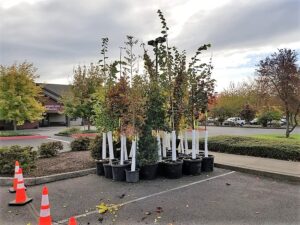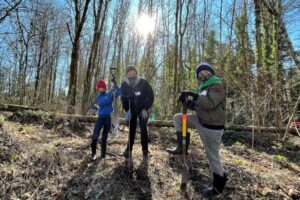Tag: partners
A Sense of Place
Students at Chemawa Indian School connect with the Indigenous relationship to the land
Friends of Trees has been partnering with the Chemawa Indian School, a Native American boarding school in Salem, for over eight years on a program designed to provide opportunities for students to build knowledge and skills that could lead to careers in the environmental field.
This year, Chase Huntley joined the team as an Education Specialist working with the Chemawa Program. He developed a syllabus around general conservation ecology and restoration, and how it connects to bigger ideas.
“It’s really important to make things culturally relevant,” Chase says. “Communities have always had a relationship to the land to the water. So I wanted to focus on the place we’re at and how it’s important to Indigenous people.”
The course is a combination of classroom, field study, and hands-on activity. The seven high school students in the class are all from different groups around the country, so much of the local land and its history was new to them. Chase hosted guest speakers to talk about Traditional Ecological Knowledge (TEK) specific to the Kalapuya and other nearby tribes.
“Because these students are at a boarding school, I wanted to make sure we got outside as much as possible,” Chase says. “There’s so many benefits to being outside, including getting to know the land.”
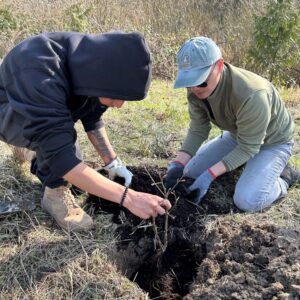
One of Chase’s goals is for the students to shift away from the Western perspective that considers people and nature as separate. From the point of view of Indigenous people, people are intricately involved with nature. “Every plant has a purpose, not just ecologically but also culturally,” he says.
Much of the classroom study considered how Indigenous people have a role in shaping the land. Weekly themes included wildlife, water, restoration, environmental justice, plants, and careers, all with the Indigenous perspective.
Students were able to build a sweat lodge, and make arrows out of willow branches. Some of the hands-on work included blackberry removal and managing other invasive species. They also worked on mulching, planting native plants, and general maintenance.
“I wanted the activities to be student-led and it turns out they really enjoyed blackberry removal, Chase says. “But not just for something to do—we made sure that we understood the why behind what we’re doing.”
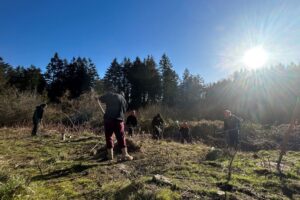
Chase is excited about the momentum the program has. His goal for this year was to build a strong foundation and develop partnerships, something he’ll continue doing next school year.
“I want to get more input from the Confederated Tribes of Grand Ronde,” he says. “There are so many resources on the land that we can study. And I want to get off the campus more too, so that we can see even more of the area.”
With more guest speakers and more field trips, students can continue to connect the dots to the big picture and develop a sense of place connected to the larger watershed and indigenous lands in the area. Students will also train as crew leaders for the first time since before the pandemic, providing them with opportunities to participate in more green space and neighborhood planting events in Salem as both volunteers and crew leaders.
“There’s so much potential with this program,” Chase says. “It all starts with focusing on the place and its importance to Indigenous people.”
Get To Know Vancouver
Our 22-Year Partnership Continues to Grow!
Our thriving partnership with the City of Vancouver shows how committed the city is to trees and community. Since we started planting in Vancouver in 2001, we have worked with their Urban Forestry team to grow tree counts and volunteer engagement.
“It’s great to work with a city that’s investing in trees to be proactive about climate change,” says Neighborhood Trees Senior Specialist Ian Bonham.
“It’s a really great partnership, working with a nonprofit to get trees in the ground and engage homeowners in stewardship,” says Jessica George, the City of Vancouver’s Urban Forestry Outreach Coordinator. “Friends of Trees really helps grow the understanding of how trees are important.”
With our new contract, the partnership has grown from 400 trees planted each season to up to 700 trees, and from 200 trees pruned to 300.
“Pruning is an important part of it,” Jessica says. “We need to make sure that the trees are cared for so that they can provide their benefits.”
“More investment means more results,” Ian says.
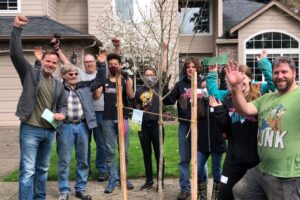
Friends of Trees has five planting events in Vancouver this season. That extra capacity has allowed us to give more attention to the Fourth Plain Corridor, a diverse, historically underserved community in need of canopy cover.
“The Fourth Plain Corridor has become a priority area for trees and engagement,” Jessica says. “Awareness of the importance of trees has really grown. We appreciate the Friends of Trees model of working with volunteers to grow the knowledge base.”
We still have room for volunteers if you want to sign up!
“We have awesome support from neighborhood coordinators,” Ian says, “and so many longtime volunteers do a lot to make it happen. It’s very collaborative, and we love to welcome new volunteers into the fold, too!”
“We’re really looking forward to it,” Jessica says. Mayor Anne McEnerny-Ogle and City Councilmember Sarah Fox will be in attendance.
We’ve also partnered with Vancouver on workforce development. They have hosted an AmeriCorps member since 2007 to work on community tree planting. In fact, both of our dedicated Vancouver staff came to us from the AmeriCorps position. The position was created to give capacity to both Friends of Trees and Vancouver as a sort of Super Neighborhood Coordinator. The position has morphed as the partnership has grown, but still supports Friends of Trees work in Vancouver. Vancouver Urban Forestry also hosts interns from our Adult Urban Forestry and Restoration Workplace Training Program.
The City of Vancouver is in the process of updating its Urban Forestry Management Plan, and is looking for public input. If you want to see more trees in your community, fill out their community survey.
Park & Ride & Shade
Partnering with TriMet to plant trees at MAX stops
We are always looking for creative places where trees can go. A MAX stop is a fantastic candidate, so when the public transportation agency TriMet came to us about a project, it made a lot of sense. Adding shade trees to MAX train stops and Park & Rides is an opportunity to improve the rider experience and address climate change at the same time.
This winter, working with TriMet with funding from the East Multnomah Soil and Water Conservation District, we planted over 100 trees at 6 different Max Stops and Park & Rides throughout Portland and Gresham.
“Trimet’s main motivation was to replace shade-producing tree canopies in our Park & Rides, as well as our swales,” says Justin Hale, Landscape Manager at TriMet. TriMet has been installing bioswales to capture and filter stormwater runoff at its MAX stops. These vegetative spaces are perfect locations for trees.
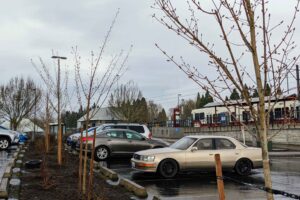
While we weren’t able to have traditional planting events at the MAX stop sites, some of the project work was completed by our crews from Portland Opportunities Industrialization Center (POIC). Much of the work was contracted to JN Landscaping, a minority-owned business in Portland.
“Transportation and tree planting are both issues that are important to our community,” Friends of Trees Deputy Director Whitney Dorer says. “This partnership was an innovative way for us to engage with transportation.”
Working with organizations like TriMet, we can find new ways to expand our tree canopy and improve heavily trafficked spaces like train and bus stops. “We are excited about replacing trees in an effort to restore our sites,” Justin says, “especially those with diminishing tree canopies.”
Get to Know Clean Water Services
A Unique Partnership in the Tualatin River Watershed
You can’t have clean water without trees. One of our oldest partnerships is with Clean Water Services, a water resource management utility that recognizes the importance of trees to watershed health. For over two decades, Clean Water Services has worked with Friends of Trees on planting events throughout Washington County, from Beaverton and Tigard to Forest Grove and Banks.
“It’s a unique partnership,” says Michelle Yasutake, the Green Space Program Manager at Friends of Trees. “To be working with a single entity that connects us to so many municipalities.”
“Friends of Trees is hugely important in our efforts to engage with the community,” says Randy Lawrence, Project Manager at Clean Water Services’ Natural Systems Enhancement & Stewardship Department. “To fulfill our investment in green infrastructure, we need community investment. We need to get their point of view.”
Clean Water Services plants trees as part of the Tree For All campaign, which has planted more than ten million native plants in the Tualatin River Watershed since 2005.

“Rather than just contracting the work out, Clean Water Services works with us to bring community engagement,” says Michelle. “And the community wants to be able to contribute and participate.”
In addition to working in public spaces, Clean Water Services has also connected Friend of Trees to private landowners through homeowners associations. Working with HOAs is important to connecting corridors of canopy where there would otherwise be gaps.
Clean Water Services has also facilitated our collaboration with groups like the Cascade Education Corps, which connects underserved youth with environmental stewardship work, and the Salmonberry Trail project, where we rescued native plants from a future recreational trail site.
“We want to make sure that who we engage with is reflective of the entire community,” Randy says. Both Friends of Trees and Clean Water Services want to continue to expand on efforts toward equity, diversity, and inclusion in the partnership moving forward.
Combined, our efforts are greater than the sum of their parts. “Working together, the scope of our projects is bigger and better,” Randy says. “And community buy-in is bigger and better.”
Friends of Trees stands with our Black colleagues, partners, and community members
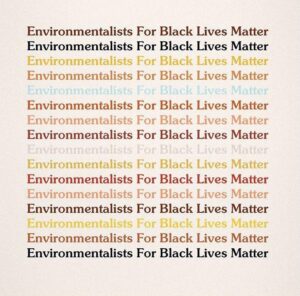
If you have come here to help me, you are wasting your time. But if you have come because your liberation is bound up with mine, then let us work together. -Lilla Watson
Friends,
Friends of Trees is incensed and stands in solidarity with the Black community. We add our voice to the many groups and institutions this week calling for justice for George Floyd, Breonna Taylor, Tony McDade, Ahmaud Aubrey, and too many others.
It is undisputed that Black, Indigenous, and all people of color bear a disproportionate impact of racial injustice and its deadly consequences. Environmental justice is among these systemic inequalities. FOT acknowledges that the Black community is more impacted by respiratory illnesses due to poor air quality making them more vulnerable. At Friends of Trees, we believe the benefits of trees should be experienced by everyone: clean air, clean water, and healthy communities are human rights. We heartily commit to listening to community needs as we work for an environmentally just future where Black folks can breathe freely.
Just as trees are connected via their root systems and intertwine underground with fungi to exchange nutrients, carbon, and water in order to survive and thrive, so too are our human communities connected. When white supremacy and police brutality affect some, it is a blight on us all. Just like a tree community’s root systems, the onus is on those with resources to combat the disease.
Friends of Trees is responding to the call for action and encourages you to join. Each and every one of us can use our voices to support the Black community. We urge you to get involved.
Onward,
Whitney Dorer, Interim Executive Director
Phoebe Krueger, Board Chair
Environmentalists For Black Lives Matter image by @greengirlleah
Get involved:
The Blueprint Foundation | The Black Parent Initiative | Black Lives Matter: PDX | Imagine Black | Equitable Giving Circle | The Black Resilience Fund | NAACP Portland | Eugene Springfield NAACP | Urban League of Portland | Coalition of Communities of Color | Momentum Alliance | Self Enhancement, Inc. | Campaign Zero | Don’t Shoot Portland | Black United Fund of Oregon

